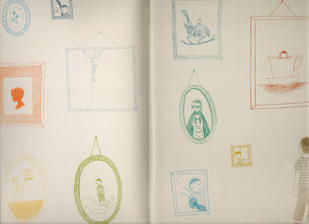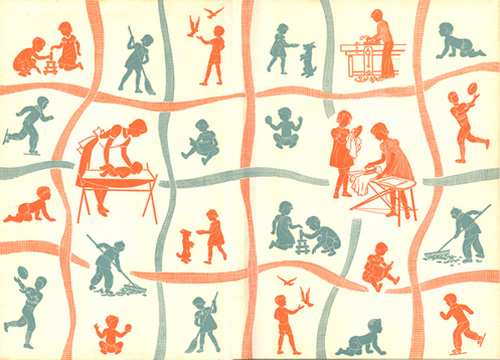|
The Art
of The End
- A Visual Celebration of the Book Endpaper
Edited by
Bob Staake and Kristen Held
 Were it not for the endpapers, a hardcover
book would literally fall apart. Were it not for the endpapers, a hardcover
book would literally fall apart.
Adhered to
the inside of the front and back covers, the endpapers are then
glued to the first and last pages within the book working almost
as a pair of hinges allowing a reader to open and close their
murder mystery, trendy novel or children's picture book -- over
and over again.
Like a washing
machine, the endpaper is firmly grounded in utility, in purpose,
with the resigned understanding that in the big scheme of things,
nobody really notices them -- unless they suddenly stop working.
They do their job, they're always there, they're dependable.
 But if there's a group
that looks beyond the endpaper's role as nothing more than a
pedestrian binding agent, it's the illustrators and designers
of books. These bibliophiles see deep into the eyes of the endpaper
and recognize its soul, its complexity, its potential as a canvas
for creative expression and unrestrained embellishment, an extra-wide
piece of pulpy real estate just dying to be showered with affection,
paint and pixels and then run through a printing press. If these
visually enlightened people aren't the least bit ashamed to judge
a book by its cover, then they're equally willing to judge them
by their endpapers, so when they're hired to personally create
a set of endpapers, well, it's a little like sending an octopus
with a shoe fetish into a Macy's with a no-limit VISA card. But if there's a group
that looks beyond the endpaper's role as nothing more than a
pedestrian binding agent, it's the illustrators and designers
of books. These bibliophiles see deep into the eyes of the endpaper
and recognize its soul, its complexity, its potential as a canvas
for creative expression and unrestrained embellishment, an extra-wide
piece of pulpy real estate just dying to be showered with affection,
paint and pixels and then run through a printing press. If these
visually enlightened people aren't the least bit ashamed to judge
a book by its cover, then they're equally willing to judge them
by their endpapers, so when they're hired to personally create
a set of endpapers, well, it's a little like sending an octopus
with a shoe fetish into a Macy's with a no-limit VISA card.
 Illustrators and designers
may love creating book covers, interior illustrations and lavish
two-page spreads, but what many of them enjoy most is taking
on the endpapers. In most cases, the endpapers are indeed the
last thing an illustrator or designer tackles on their book,
if only because it is the visual tone of the interior page imagery
that dictates or overtly suggests the endpaper's appropriate
graphic treatment. Maybe the art from the book will be modified
and repeated in a hip "wallpapered" pattern. Perhaps
an expansive new illustration will be created touching on numerous
scenes within the book. Or could the endpapers in some way suggest
a completely new world hinted at within the book, but not yet
revealed -- except right here and now on the endpapers? Illustrators and designers
may love creating book covers, interior illustrations and lavish
two-page spreads, but what many of them enjoy most is taking
on the endpapers. In most cases, the endpapers are indeed the
last thing an illustrator or designer tackles on their book,
if only because it is the visual tone of the interior page imagery
that dictates or overtly suggests the endpaper's appropriate
graphic treatment. Maybe the art from the book will be modified
and repeated in a hip "wallpapered" pattern. Perhaps
an expansive new illustration will be created touching on numerous
scenes within the book. Or could the endpapers in some way suggest
a completely new world hinted at within the book, but not yet
revealed -- except right here and now on the endpapers?
And how illustrators
and designers of books choose to embellish endpapers in so many
diverse ways makes them a veritable showcase for visual experimentation,
risk taking and untethered creativity. Indeed, editors and publishers
can be very particular when it comes to the images that will
adorn a book's cover and interior spreads, but when it comes
to the endpapers, they are more apt to allow an illustrator or
designer to get a little crazy, try something unexpected, shoot
for the moon.
Filled with
over 240 examples of uncommon vintage and contemporary endpapers,
the book is intended first and foremost as a beautifully designed
visual feast, but the engaging text and captions also provide
history, facts and light analysis of each endpaper example.
The Art
of The End
celebrates the endpaper as an underappreciated art form, but
more importantly as an uncommon venue for publishers to preserve
an intrinsic tradition and tactile component of their creative
product -- one that can't be found on tv, radio, or the internet
-- only when a reader opens a printed book.
For this reason
alone, The Art of The End should be published.
|